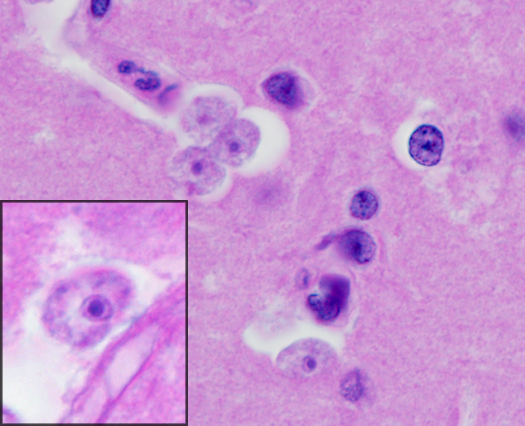Halloween often conjures up images of brain-eating zombies. Well, I am covering the closest thing in nature to that concept, the brain-eating ameba (Naegleria fowleri) by Giant Microbes! I should start off by saying these toys belong to a friend of mine at work (who is also our medical director for parasitology), as I don’t collect plush toys myself. Naegleria fowleri is a free-living ameba that lives is warm fresh water, soil, thermal discharges from power plants, geothermal wells, and community water sources that are not adequately chlorinated. It is actually not a true parasite, as it is not adapted to living in a host, but rather an opportunistic pathogen. It is also not a true ameba, being more closely related to flagellated protozans, such as Giardia. Infection usually occurs when the trophozoite or flagellated forms (more on the life cycle stages later) are forcefully introduced into the nose, such as when jumping or diving in a warm pond or lake, or by the misuse of nasal irrigation devices! The parasite crosses the cribriform plate and travels via the olfactory nerve to the brain, where it multiplies, causing a condition called primary amebic meningoencephalitis (PAM). Unfortunately, onset of symptoms is rapid, and once symptoms are present, death is usually inevitable. It is most commonly seen in children and teenagers; it is believed younger people are more susceptible because the cribriform plate is not as well developed, allowing for easier access to the olfactory nerve.


Naegleria has three stages: cyst, trophozoite, and flagellated form. First, we will look at the cyst. The cyst is the life cycle stage responsible for dormancy and survival when environmental conditions are not optimal for feeding and reproduction. The cyst has a single nucleus (although this toy, as all three in the set, has a nucleus on both sides; it is probably intended to represent the same nucleus, viewed from two different sides). The single-layered cyst wall is represented by a red frill around the cyst. The cyst stage is never seen in human tissues.

Next is the flagellated form. This stage is for locomotion in an aqueous environment and is induced when trophozoites are exposed to a change in ionic concentration. Once introduced within the nasal mucosa, flagellated forms transform into trophozoite forms. Flagellated forms are not found in human tissues, but may be observed in cerebrospinal fluid (CSF).

Last is the trophozoite stage. This is the feeding and replication stage, and the stage infective for humans. In the environment, trophozoites normally feed on bacteria. Movement is by pseudopods, which on this figure are represented by a thick red frill. This is the only stage observed in human tissue specimens. In tissue specimens (see last image) they usually appear rounded.

Lastly, here is an image I took for a book chapter I co-authored a couple years ago with fellow parasitologist and friend Dr. Bobbi Pritt. It shows four trophozoites of N. fowleri in a brain autopsy specimen (inset shows a close-up of a trophozoite):

Well, that’s the first of at least three ‘scary’ critters I have planned for this month. Hope you enjoyed it. Next time you jump in a lake or pond on a warm summer’s day, remember to plug your nose!
Disclaimer: links to Ebay and Amazon on the AnimalToyBlog are affiliate links, so we make a small commission if you use them. Thanks for supporting us!




This is no doubt the creepiest critter that will be featured here this month. Well chosen!